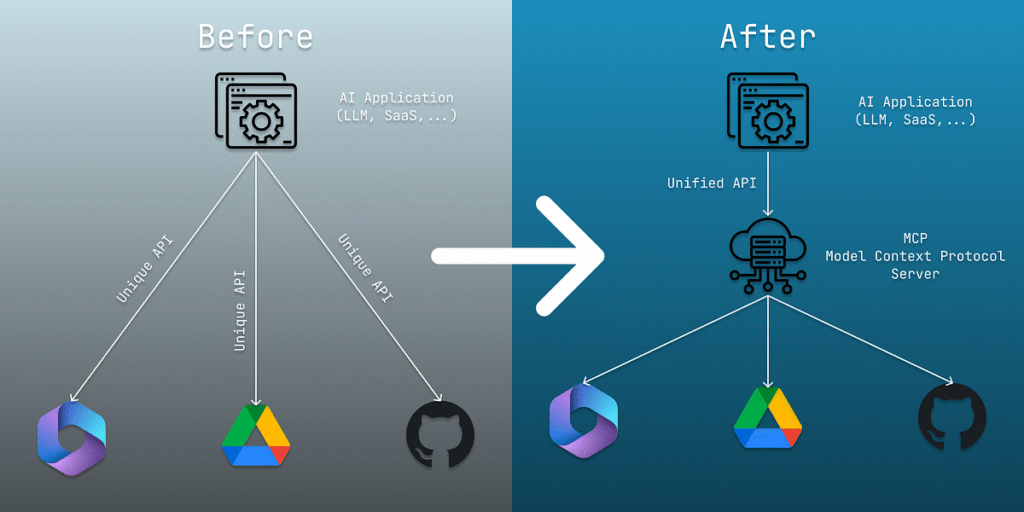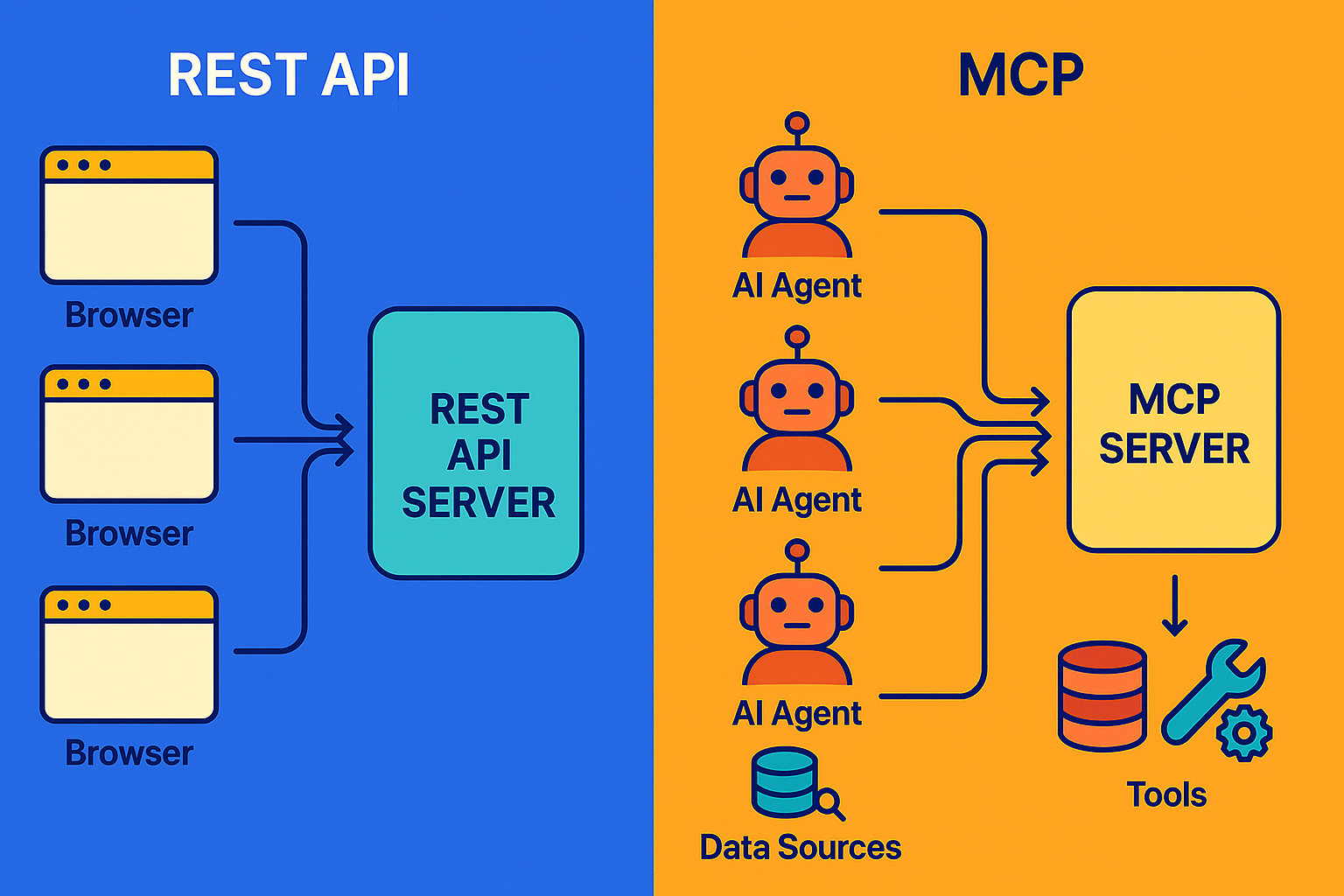If you’ve ever heard terms like MCP or API and felt confused, don’t worry — you’re not alone. These are technical tools used to help software talk to each other, but they serve different purposes and work in slightly different ways.
In this post, we’ll break down what MCP and API are, how they compare, and why both are important — especially as AI becomes more integrated into everyday tools.
What is an API?
API stands for Application Programming Interface.
Think of it like a menu at a restaurant:
- You (the customer) don’t go into the kitchen to cook your meal.
- Instead, you use the menu (the API) to tell the kitchen (the system) what you want.
- The kitchen then prepares the food (processes the request) and gives it back to you.
Example of an API:
When you check the weather on your phone:
- Your app uses an API to ask a weather service, “What’s the weather today?”
- The weather service responds with the data.
- You see the result without needing to know how the weather data was collected.
Key Features of APIs:
- Used by developers to connect apps with external services.
- Often requires keys or tokens for security.
- Typically follows formats like REST, GraphQL, or SOAP.
- Great for integrating existing systems.
What is MCP?
MCP stands for Model Control Protocol.
It’s a newer idea that’s gaining traction in the world of AI coding assistants and AI agents. Think of MCP as a customizable toolbox for AI:
- It allows AI models to access tools, resources, and prompts.
- These can be things like:
- Reading and writing files.
- Searching the web.
- Accessing databases.
- Using internal documentation or knowledge bases.
Example of MCP:
Imagine you’re using an AI assistant to build a website:
- You ask it to add notes, read them, or even generate a summary.
- With MCP, the AI doesn’t just guess — it uses tools to actually do those tasks, just like a human would.
- How Does MCP Work?
1. MCP Servers: The Tools Behind the Magic
At the core of MCP are MCP servers — these are small programs (like Python scripts) that expose tools, resources, and prompts to an AI agent.
MCP vs API: The Main Differences
| Feature | API | MCP |
|---|---|---|
| Purpose | Connects apps/services | Extends AI capabilities |
| Who Uses It | Developers | AI agents & coders |
| How It Works | Standardized endpoints | Custom tools & resources |
| Use Case | Integrating third-party services | Giving AI superpowers |
| Security | Often needs API keys | Built-in permissions per tool |
| Ease of Use | Requires developer knowledge | Designed for natural language |
How Does MCP Work?

Instead of building custom APIs for every AI integration, MCP provides a unified protocol that agents can use to communicate with tools, databases, and external services — much like how web browsers use HTTP.
How MCP Works (Step-by-Step)
1. Agent Sends a Request
An AI agent sends a task or query to an MCP server — this could be something like:
“Find all overdue invoices and send reminders.”
2. MCP Server Interprets Context
The MCP server:
- Understands the intent of the request
- Knows the agent’s memory, role, and prior actions
- Routes the request to appropriate tools, data, or sub-agents
3. Tool Interaction
The MCP server interfaces with:
- APIs (e.g., Google Drive, GitHub, SQL databases)
- Local tools (e.g., Python scripts)
- Other AI agents
All of this happens using a standard JSON-based format (like OpenAI’s function calling or Open Agents).
4. Response Aggregation
The MCP server:
- Receives results from tools
- Optionally aggregates, filters, or transforms the data
- Returns the output to the AI agent in context-aware form
5. Agent Acts or Responds
Based on the result, the agent:
- Updates its memory or plan
- Executes follow-up tasks
- Returns a final output to the user
Example Use Case
Without MCP:
- You write custom code to call APIs like Slack, Google Docs, and a database.
With MCP:
- An AI agent calls
get_documents("invoices"), and the MCP server handles the rest via tool integrations.
Key Components
| Component | Role |
|---|---|
| AI Agents | The “workers” that request and act on tasks |
| MCP Server | Routes, tracks, and manages requests, memory, and tools |
| Tools | APIs, databases, Python functions — all abstracted behind interfaces |
| Memory/Context | Stores history, roles, goals for each agent |
Benefits of MCP
- Unified Interface: One API to talk to all services
- Modular: Easy to add/remove tools
- Agent-Oriented: Built for LLM-driven workflows
- Composable: Tools, memory, and agents can be orchestrated dynamically
Why MCP Matters Now
As AI coding tools become more popular (like Cursor, Windsurf, or Claude Desktop), MCP helps bridge the gap between what AI knows and what it can do.
For example:
- An AI can write code, but with MCP, it can also:
- Create database tables.
- Search the internet.
- Read and save notes.
- Use custom prompts and templates.
This makes AI much more useful for real-world development and problem-solving.
When to Use API vs MCP
Use an API when:
- You’re connecting two existing systems.
- You need data from a service (e.g., weather, maps, payments).
- You’re building traditional apps or integrations.
Use MCP when:
- You’re working with AI assistants or agents.
- You want to give AI specific tools to interact with your environment.
- You’re building something new and need flexibility.
Final Thoughts
While APIs have been around for years and are essential for modern software, MCP is a fresh way to make AI more powerful and helpful — especially in coding and development.
If you’re a developer or someone who uses AI tools regularly, understanding both APIs and MCP will help you get the most out of technology — whether you’re building apps, automating tasks, or creating smart workflows.
